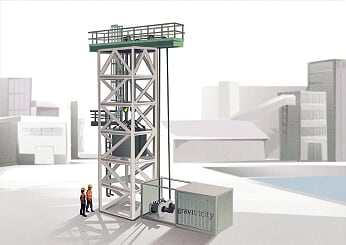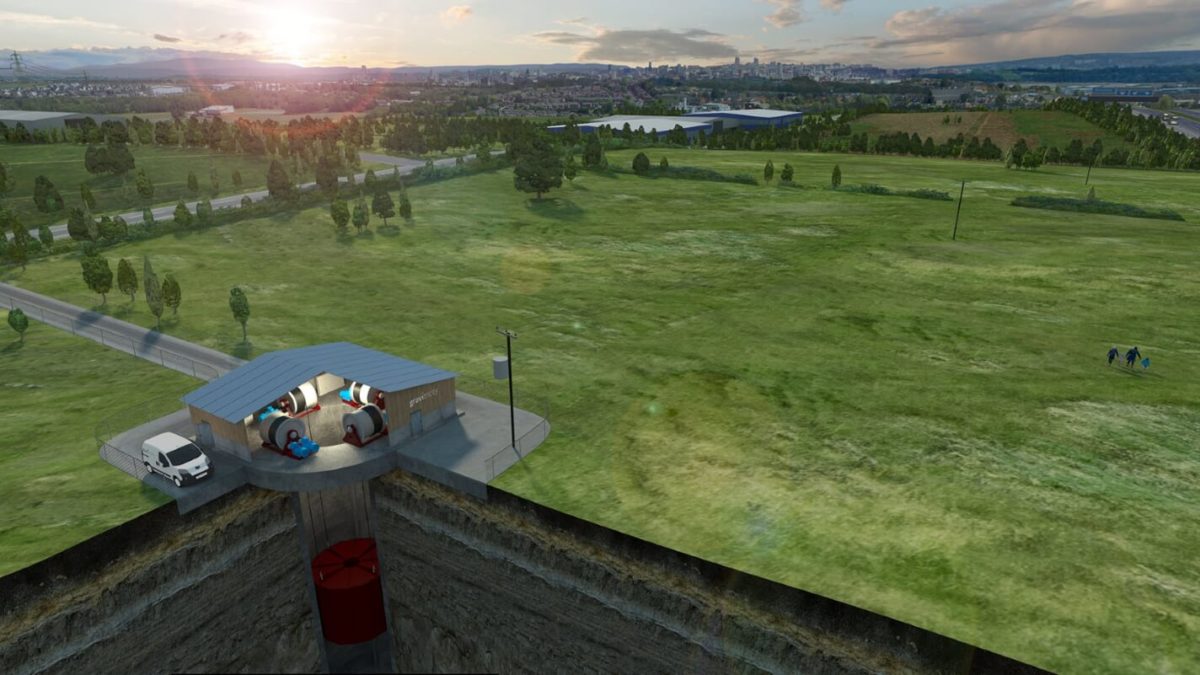Scottish start-up Gravitricity has developed a gravity energy storage system it says is perfect for storing solar and wind power.
A 16m-high rig uses the clean power to raise a mass in a 150-1500m shaft and discharges the electricity thus ‘stored’ by releasing the mass to rotate an electric generator.
Gravitricity said the mass used can range from 500 to 5,000 tons and the electricity discharged could power 30,000 nearby homes for two hours.
The start-up claimed sophisticated winches and a control system can lower the mass very quickly, making it flexible enough to stabilize electricity networks at 50Hz and ensuring the set-up can respond to full power demand in less than a second. “Our technology has the fast response time of lithium-ion batteries,” the company said.
The Edinburgh-based company said the system offers 25-year service without loss of performance or cyclical degradation and can be sited anywhere, including in city centers. The developer pointed to disused mine shafts as ideal locations, however.
Demonstrator
Gravitricity will begin construction of a £1 million (€1.14 million) pilot project in October on an industrial site at Port of Leith, Scotland’s largest enclosed deep-water port.
With completion scheduled for December, the 250 kW prototype will be connected to the port’s power network and have its speed of response for grid stabilization assessed. “The demonstrator at the Port of Leith will allow the technology to be trialed on a much smaller scale, utilizing an above ground structure,” the company said.
The pilot system will use two 25-tonne weights suspended by steel cables. “This two-month test program will confirm our modeling and give us valuable data for our first full-scale, 4 MW project, which will commence in 2021,” said Gravitricity lead engineer Miles Franklin.
The lattice tower for the Port of Leith facility will be supplied by U.K. engineer Kelvin Power and the winches and control system will come from Huisman, a Dutch manufacturer of heavy lifting, drilling, pipe laying and mooring systems.
The project is being backed by government agency Innovate UK with a £640,000 grant.
Gravity storage
U.S. company Energy Vault unveiled gravity-based storage technology relying on a crane and 35-ton concrete blocks a year ago. That system was said to take account of volatility in energy supply and demand, weather conditions and inertia, according to its developer, and was backed by a $110 million (€102 million) investment from Japanese lender SoftBank in August. “Energy Vault will be demonstrating the first 35 MWh storage tower, in the north of Italy in 2019,” the Japanese conglomerate announced at the time.
Austrian research organization the International Institute for Applied Systems Analysis (IIASA) last year suggested gravitational energy storage for low-energy-demand locations. In that instance, the technology put forward involved dual cranes on a mountain cliff-edge connected to an energy storage site at the base of the drop plus an electric motor on an upper storage site to transport a solid mass of sand or gravel. IIASA scientists said such a system could be combined with other forms of energy storage and renewables, would cost $50-100 per megawatt-hour of stored energy and $1-2 million per megawatt of installed storage capacity to develop.
This content is protected by copyright and may not be reused. If you want to cooperate with us and would like to reuse some of our content, please contact: editors@pv-magazine.com.




I think the problem is that it’s hard to scale.
Why don’t they consider flywheel energy storage for providing peak demand?
How is your Zero-G Training Worf?
There’s a much simpler solution than raising a weight – raising water. A weight is either going up or down. There’s nothing in the middle. You raise the weight while the wind or sun are good, and let it go down when they stop. This will cause a slight gap in the power supply and wear and tear on the mechanism.
On mount Gilboa (known in the Bible) in Israel, there is a really good gravity arrangement that uses water. During the night, when there is an excess of cheap conventionally produced power on the grid, it is used to raise water to a reservoir on the top of the mountain. During the day, when grid electricity is expensive and demand is high, the water rushes down a chute to power a generator at the bottom of the mountain. It works well. It relies mostly on the economic principle of cheap electricity at night, but does make good use of it instead of letting it go to waste.
The same principle can be applied to solar and wind. They would constantly use most of their power to raise water, which would constantly be producing electricity by gravitation. The only time there could be a problem is when the reservoir at the top runs dry due to a long spell of lack of wind or sun.
And where are you going to billed and I would like to see your new system as I work in this industry.
I wonder how much electricity is used to keep the shaft free of water? Any deep hole dug in Scotland is likely to fill with ground water.
Lets look at the numbers Power – 250kW , Time – 2hrs , Energy Store – 500kWh
Potential energy required to deliver this (mgh) = 500kWh or 1800 MJ.
Assume efficiency of hoisting & lowering (motor/alternator losses + winch losses) of 80% = = 1800/0.8 = 2250 MJ needs storing.
and what options we have – mass, mine shaft depth and endless mechanical issues.
For a 25 t weight, we need a shaft of 9 km. If the shaft is 2km (best case), you need a weight of 140 ton. Now imagine a 4 MW storage set up. A 5000 t mass would need a 45 m depth – reasonable but the mass would be a iron cylinder of 10m height x5m radius.
Commercially cost per unit energy is prohibitive.